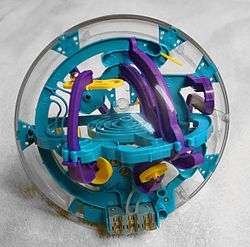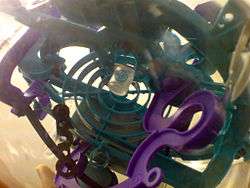Perplexus
Perplexus is a 3-D ball-in-a-maze puzzle or labyrinth game enclosed in a transparent plastic sphere. By twisting and turning the sphere, players attempt to maneuver a small steel ball through an intricate maze composed of a certain number of steps (varying in each puzzle) along narrow plastic tracks. The number of steps ranges from 30 in the Perplexus Twist, to 125 in the Perplexus Epic. Some of the steps involve dropping the ball into a cup or through a small rim to take advantage of its three-dimensional nature. There are obstacles of varying difficulty that must be negotiated in order to reach the end.
| Type | Ball-in-a-Maze Puzzle |
|---|---|
| Inventor(s) | Michael McGinnis, Brian Clemens, Dan Klitsner |
| Company | Perplexus LLC |
| Country | United States |
| Availability | 2000–Present |
| Official website | |
Perplexus LLC is the manufacturer and a wholly owned subsidiary of Spin Master Ltd (since 2017).[1]
History
Perplexus was co-invented by teacher and magician Michael McGinnis and toy inventors Brian Clemens and Dan Klitsner of San Francisco-based KID Group—known for the invention of the games Bop It, HyperDash, and other titles. McGinnis first sketched ideas for three-dimensional labyrinths in the late 1970s. Years later, he showed sketches and rough prototypes to Clemens and Klitsner (1999). After a year of collaboration and many prototypes, they perfected the toy's gameplay so that it was easy enough for a young child to start, yet challenging for any age due to its many levels.
Versions
There are currently fourteen versions of Perplexus: Original (re branded as Beast in 2019), Rookie (re branded as Rebel also in 2019), Epic, Twist, Warp, Small Original, Q-Bot, Star Wars Death Star, Mini Spiral, Mini Cascading Cups, Harry Potter Prophecy, Light Speed, Drakko, and the Revolution. These Perplexus balls can also be painted differently, such as in the Yellow Rookie.
Superplexus


In 2001, a version of the Perplexus Ball, called Superplexus, was launched with limited availability. This version has an electronic timer. [2]
References
- "Spin Master grows games segment with Perplexus buy". Retrieved 2020-03-06.
- "Spin Master - Play Online Games, Watch Videos And More!". www.perplexus.net. Retrieved 2020-03-06.
External links
- Michael McGinnis's page about the development of Superplexus
- An article in SFGate about SuperPlexus
- A video interview with Michael McGinnis about the development of Superplexus
- The officially licensed website and makers of Perplexus
- The official UK Distributor of the Perplexus